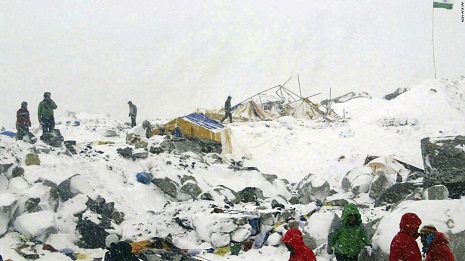Reports received so far by the government and aid groups suggest that many communities perched on mountainsides are devastated or struggling to cope. Udav Prashad Timalsina, the top official for the Gorkha district, near the epicenter of Saturday`s quake, said he was in desperate need of help.
"There are people who are not getting food and shelter. I`ve had reports of villages where 70 percent of the houses have been destroyed," he said.
He said 223 people had been confirmed dead in the district but he presumed "the number would go up because there are thousands who are injured."
"Villages like this are routinely affected by landslides, and it`s not uncommon for entire villages of 200, 300, up to 1,000 people to be completely buried by rock falls," said Matt Darvas, a member of the aid group World Vision. "It will likely be helicopter access only."
Timalsina said his district had not received enough help from the central government, but Jagdish Pokhrel, the clearly exhausted army spokesman, said nearly the entire 100,000-soldier army was involved in rescue operations.
"We have 90 percent of the army out there working on search and rescue," he said. "We are focusing our efforts on that, on saving lives."
Meanwhile, tens of thousands of newly homeless families slept on the streets of the capital, Kathmandu, for a second consecutive night Sunday. Kathmandu district chief administrator Ek Narayan Aryal said tents and water were being handed out Monday at 10 locations in Kathmandu, but that aftershocks were leaving everyone jittery.
"There have been nearly 100 earthquakes and aftershocks, which is making rescue work difficult. Even the rescuers are scared and running because of them," he said.
Tens of thousands spent the night sleeping in parks or on a golf course. Others camped in open squares lined by cracked buildings and piles of rubble.
It`s overwhelming. It`s too much to think about," said 55-year-old Bijay Nakarmi, mourning his parents, whose bodies recovered from the rubble of what once was a three-story building.
He could tell how they died from their injuries. His mother was electrocuted by a live wire on the roof top. His father was cut down by falling beams on the staircase.
He had last seen them a few days earlier -- on Nepal`s Mothers` Day -- for a cheerful family meal.
"I have their bodies by the river. They are resting until relatives can come to the funeral," Nakarmi said as workers continued searching for another five people buried underneath the wreckage.
The capital city is largely a collection of small, poorly constructed brick apartment buildings. But outside of the oldest neighborhoods, many in Kathmandu were surprised by how few modern structures collapsed in the quake.
The earthquake was the worst to hit the South Asian nation in more than 80 years. It destroyed swaths of the oldest neighborhoods of Kathmandu and was strong enough to be felt all across parts of India, Bangladesh, China`s region of Tibet and Pakistan.
Nepal`s worst recorded earthquake in 1934 measured 8.0 and all but destroyed the cities of Kathmandu, Bhaktapur and Patan.
Rescuers aided by international teams spent Sunday digging through rubble of buildings - concrete slabs, bricks, iron beams, wood - to look for survivors. Because the air was filled with chalky concrete dust, many people wore breathing masks or held shawls over their faces.
Hundreds of people in Kathmandu`s western Kalanki neighborhood nervously watched the slow progress of a single backhoe digging into the rubble of the collapsed Lumbini Guest House, once a three-story budget hotel.
Most areas were without power and water. The United Nations said hospitals in the Kathmandu Valley were overcrowded and running out of emergency supplies and space to store corpses.
Most shops in Kathmandu were closed after the government declared a weeklong period of recovery. Only fruit vendors and pharmacies seemed to be doing business.
"More people are coming now," fruit seller Shyam Jaiswal said. "They cannot cook so they need to buy something they can eat raw."
Jaiswal said stocks were running out, and more shipments were not expected for at least a week, but added, "We are not raising prices. That would be illegal, immoral profit."
The quake will probably put a huge strain on the resources of this impoverished country best known for Everest, the highest mountain in the world. The economy of Nepal, a nation of 27.8 million people, relies heavily on tourism, principally trekking and Himalayan mountain climbing.
The first nations to respond were Nepal`s neighbors - India, China and Pakistan, all of which have been jockeying for influence over the landlocked nation. Nepal remains closest to India, with which it shares deep political, cultural and religious ties.
Other countries sending support Sunday included the United States, Canada, the United Arab Emirates, Britain, Germany, France, Poland, Italy, Israel and Singapore.
An American military plane left Delaware`s Dover Air Force Base for Nepal, carrying 70 people, including a disaster-assistance response team and an urban search-and-rescue team, and 45 tons of cargo, the Pentagon said.
More about:
















































